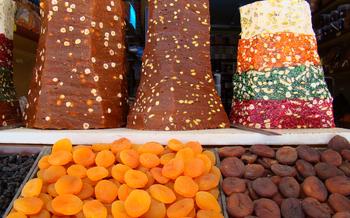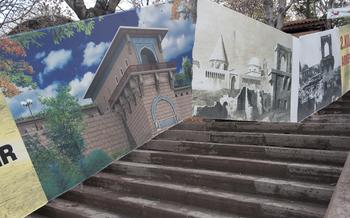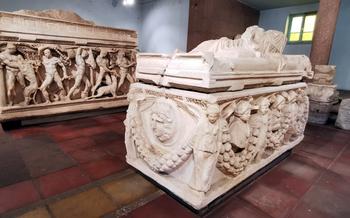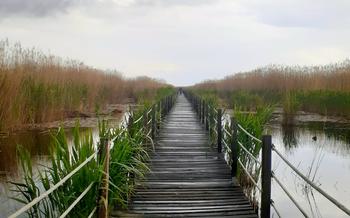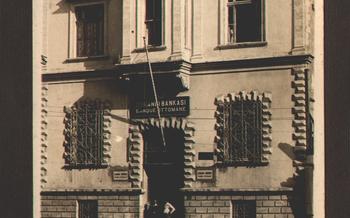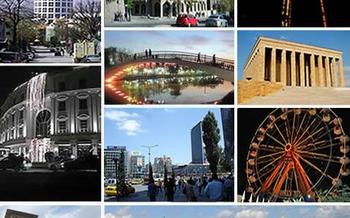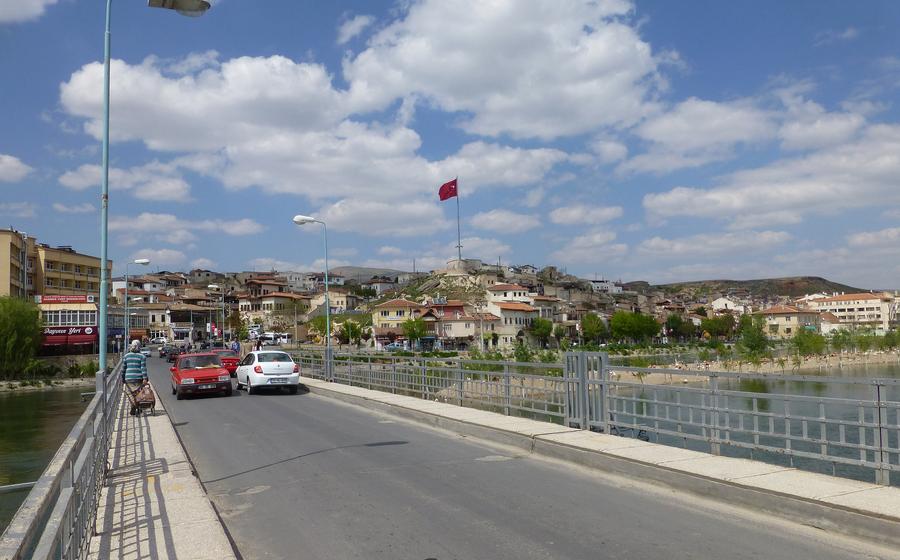
Avanos Bridge
- A Pottery Hub
- Avanos Bridge Historical Overview
- The Red River: A Source of Artistic Inspiration
- Pottery Workshops and Classes
- Pottery Shopping in Avanos
- The Avanos Festival: A Celebration of Pottery and Culture
- Local Cuisine
- Avanos Art Gallery: A Haven for Artistic Expression
- The Hacıbektaş Veli Complex:
- The Ihlara Valley: A Geological and Historical Wonderland
- Geological Marvels:
- Hiking Trails and Scenic Viewpoints:
- Historical Treasures:
- Tips for Exploring:
- The Underground City of Özkonak
- The Güllüdere Valley:
- Insider Tip: Unveiling the Secret Pottery Workshop
A Pottery Hub
Avanos, a charming town nestled in the heart of Turkey's Cappadocia region, is renowned for its rich pottery-making heritage, dating back to the Hittite era. The town's artisans have mastered the art of transforming the region's unique clay into exquisite pottery pieces, earning Avanos a reputation as a pottery hub.
The pottery-making process in Avanos involves a blend of traditional techniques and locally sourced materials. The Red River, which flows through the town, provides an abundance of high-quality clay, renowned for its distinct reddish hue. Artisans skillfully mold this clay into various forms, using techniques passed down through generations, such as hand-building, wheel-throwing, and glazing.
Avanos pottery is characterized by its intricate designs, vibrant colors, and unique shapes. Artisans often incorporate traditional Anatolian motifs, such as geometric patterns, floral designs, and animal figures, into their work. The pottery ranges from decorative items like vases, plates, and bowls to functional pieces such as jugs, jars, and cookware.
Visitors to Avanos can immerse themselves in the town's pottery culture by exploring the numerous pottery shops and workshops. These establishments showcase a wide variety of pottery pieces, allowing visitors to admire the craftsmanship and purchase unique souvenirs. Some workshops even offer hands-on pottery classes, providing visitors with an opportunity to learn the art of pottery-making firsthand.
Avanos Bridge Historical Overview
The Avanos Bridge is an ancient stone bridge that spans the Red River in Avanos, Turkey. It is believed to have been built by the Romans in the 2nd century AD and has since undergone several renovations and repairs throughout the centuries. The bridge consists of three arches, with the central arch being the largest and most impressive. It is supported by massive stone pillars and features intricate carvings and decorations on its surface.
The Avanos Bridge has played a significant role in the history and development of the city. It served as a vital trade route, connecting Avanos to other regions and facilitating the transportation of goods and people. The bridge also provided a safe passage for travelers and pilgrims, who frequently passed through Avanos on their journeys. Its strategic location made it a crucial point of defense during times of conflict and invasions.
Over the centuries, the Avanos Bridge has become an iconic symbol of the city and a testament to its rich historical heritage. It has withstood the test of time, enduring floods, earthquakes, and wars, and continues to stand as a majestic landmark that attracts visitors from around the world. Its architectural beauty and historical significance make it a must-see destination for anyone exploring the wonders of Avanos.
The Red River: A Source of Artistic Inspiration
The Red River, also known as the Kızıl Irmak, plays a crucial role in Avanos' pottery tradition. Its unique red clay, rich in minerals and possessing a distinct color, has been a source of inspiration for potters for centuries. The river's clay is highly valued for its plasticity, allowing potters to create intricate designs and shapes with ease.
The Red River's clay is carefully extracted from the riverbanks and then processed to remove impurities. It is then mixed with water and other natural materials to create a smooth, workable clay body. The unique color of the clay is attributed to the presence of iron oxide, which gives the final product its characteristic reddish hue.
Potters in Avanos utilize the Red River's clay to create a wide range of pottery, including decorative plates, vases, bowls, and figurines. The clay's unique properties allow potters to achieve intricate details and vibrant colors, making each piece a true work of art.
In addition to its role in pottery, the Red River also holds significant environmental importance. The river's ecosystem is home to a diverse range of plant and animal species, and its waters are vital for irrigation and agriculture in the region. Conservation efforts are underway to protect the river's natural beauty and ensure its sustainable use for future generations.
Pottery Workshops and Classes
Avanos is a haven for pottery enthusiasts, offering a range of workshops and classes that cater to all skill levels. Whether you're a novice looking to try your hand at the potter's wheel or a seasoned potter seeking to refine your techniques, Avanos has something for everyone.
Many workshops are located in the heart of the pottery district, allowing you to immerse yourself in the creative atmosphere and learn from experienced local artisans. Classes typically cover the basics of pottery, including clay preparation, throwing techniques, glazing, and firing. You'll have the opportunity to work with high-quality materials and receive personalized guidance from skilled instructors.
For those interested in a more in-depth experience, consider enrolling in a multi-day workshop or masterclass. These programs often focus on specific pottery techniques or styles, such as traditional Turkish pottery, raku firing, or hand-building. You'll have the chance to delve deeper into the art form, experiment with different clays and glazes, and create a portfolio of unique pieces.
Taking a pottery class in Avanos is a rewarding and enriching experience. Not only will you learn a new skill and create beautiful handmade objects, but you'll also gain a deeper appreciation for the artistry and craftsmanship that goes into each piece of pottery. Whether you're looking for a fun and creative activity or a serious pursuit, Avanos' pottery workshops and classes are sure to inspire and engage.
Tips for Choosing the Right Workshop or Class
-
Consider your skill level. If you're a beginner, look for workshops that cater to newcomers and provide basic instruction. Experienced potters may prefer more advanced classes or workshops that focus on specific techniques or styles.
-
Check the class size. Smaller classes often offer more personalized attention from the instructor, while larger classes may provide a more social and interactive environment.
-
Read reviews and recommendations. Look for workshops or classes that have received positive feedback from previous students.
-
Inquire about the materials and equipment provided. Make sure the workshop provides all the necessary materials and equipment, including clay, glazes, and firing services.
-
Consider your budget. Pottery workshops and classes can vary in price depending on the length, skill level, and materials included. Be sure to compare prices and choose a class that fits your budget.
Pottery Shopping in Avanos
Avanos is a potter's paradise, and there are many opportunities to shop for unique and beautiful pieces. The best places to find pottery are the workshops and shops along the Red River. Here, you can watch the potters at work and browse their collections. You can also find pottery in the Avanos Bazaar, a traditional Turkish market.
When shopping for pottery in Avanos, it is essential to know how to identify high-quality pieces. Look for pottery that is well-made and has a smooth finish. The glaze should be even and free of cracks or bubbles. The colors should be vibrant and not muddy.
Bargaining is expected when shopping in Avanos. Prices are usually negotiable, so don't be afraid to offer a lower price. However, be respectful and don't try to haggle too much.
Once you have purchased your pottery, it is essential to pack and transport it safely. Wrap each piece in bubble wrap or newspaper and pack it in a sturdy box. If you are flying home, pack your pottery in your carry-on luggage so that it does not get damaged in transit.
The Avanos Festival: A Celebration of Pottery and Culture
The Avanos Festival is an annual event that celebrates the rich pottery tradition of the region and its vibrant cultural heritage. It is a time when the town comes alive with music, dance, and art, as locals and visitors gather to honor the craft that has shaped their community for centuries.
The festival typically takes place in June and features a variety of events and activities, including pottery demonstrations, workshops, exhibitions, and competitions. Visitors can witness the skill and artistry of local potters as they create unique pieces using traditional techniques passed down through generations. There are also opportunities to learn about the history and cultural significance of Avanos pottery, as well as to purchase handcrafted items directly from the artisans.
In addition to pottery-related activities, the festival offers a range of other attractions, such as live music performances, traditional dance shows, and culinary delights. Visitors can savor the flavors of local cuisine, including specialties made with fresh, seasonal ingredients. The festival also provides a platform for local artists to showcase their work, including paintings, sculptures, and textiles.
For those who wish to make the most of their festival experience, it is recommended to plan their visit in advance. Accommodation options in Avanos tend to fill up quickly during this time, so booking early is advisable. It is also a good idea to research the festival program and identify the events and activities that align with your interests.
Whether you are a pottery enthusiast, a culture lover, or simply seeking a unique and immersive experience, the Avanos Festival is an event not to be missed. It is an opportunity to celebrate the artistry, heritage, and hospitality of this vibrant town, while taking home a piece of its rich pottery tradition.
Local Cuisine
Avanos's cuisine is a delightful blend of Turkish and Anatolian flavors, offering a unique culinary experience to visitors. The city is renowned for its fresh ingredients, traditional cooking methods, and an array of dishes that showcase the region's rich cultural heritage.
Among the must-try dishes in Avanos is the Testi Kebab, a tender lamb meat slowly cooked in a sealed clay pot. The meat absorbs the flavors of the spices and juices, resulting in a succulent and flavorful dish. Another local specialty is Avanos Mantısı, small dumplings filled with minced meat and served with a garlic-yogurt sauce.
For those with a sweet tooth, Avanos offers a variety of delectable desserts. The Katmer, a flaky pastry filled with nuts and honey, is a local favorite. Şekerpare, sweet syrup-soaked cookies, are another delightful treat.
For a truly authentic dining experience, visitors should explore the local restaurants and eateries in Avanos. The Hanedan Restaurant is a popular choice, offering a wide range of traditional Turkish dishes. The Çömlekçi Restaurant is another great option, specializing in pottery-cooked dishes.
For vegetarians and those with dietary restrictions, Avanos offers a variety of options. Mezze platters, featuring a selection of small dishes such as hummus, baba ghanoush, and stuffed grape leaves, are a great way to sample the local cuisine without meat. Many restaurants also offer grilled vegetables, salads, and fresh fruit.
Whether you're a food enthusiast or simply looking for a taste of local culture, Avanos's cuisine is sure to tantalize your taste buds and leave you wanting more.
Avanos Art Gallery: A Haven for Artistic Expression
In the heart of Avanos, the Avanos Art Gallery stands as a testament to the region's rich artistic heritage. Established in 1972, the gallery has become a renowned platform for local artists to showcase their creations and connect with art enthusiasts from around the world.
Within the gallery's walls, visitors are greeted by a diverse collection of pottery, paintings, sculptures, and other artworks that reflect the essence of Avanos' artistic traditions. The pottery section features an array of intricately designed pieces, showcasing the exceptional craftsmanship of local potters. From delicate vases and plates to elaborate decorative items, each piece tells a story of creativity and cultural heritage.
The gallery also houses a collection of paintings that capture the stunning landscapes, vibrant colors, and unique perspectives of Avanos and its surroundings. From serene depictions of the Red River and the Ihlara Valley to abstract expressions of the region's cultural heritage, these paintings offer a visual feast for art lovers.
In addition to pottery and paintings, the Avanos Art Gallery showcases a variety of sculptures, ranging from traditional Anatolian motifs to contemporary abstract forms. These sculptures, crafted from various materials such as wood, stone, and metal, add a three-dimensional element to the gallery's collection, inviting visitors to explore the depth and diversity of artistic expression.
The gallery also plays a crucial role in promoting local artists and nurturing their talents. Through regular exhibitions, workshops, and educational programs, the Avanos Art Gallery provides a platform for emerging artists to showcase their work and gain recognition. It also collaborates with local schools and art organizations to foster creativity and artistic education among the younger generation.
For visitors, the Avanos Art Gallery offers a unique opportunity to immerse themselves in the vibrant art scene of the region. With its diverse collection, inspiring atmosphere, and commitment to promoting local talent, the gallery is a must-visit destination for anyone interested in experiencing the artistic treasures of Avanos.
The Hacıbektaş Veli Complex:
The Hacıbektaş Veli Complex is a sacred site and pilgrimage center for Alevis, a branch of Islam that originated in Anatolia. The complex is located in the town of Hacıbektaş, approximately 50 kilometers from Avanos. It was built in the 13th century to honor the revered Alevi saint Hacı Bektaş Veli, who is believed to have founded the Alevi order.
The complex comprises several structures, including a mosque, a dervish lodge, a türbe (mausoleum), and a museum. The mosque is a beautiful example of Seljuk architecture, featuring intricate tilework and calligraphy. The dervish lodge, where Alevi rituals and ceremonies were once held, has been converted into a museum showcasing artifacts related to Hacı Bektaş Veli and Alevism.
The türbe is the most sacred part of the complex, where Hacı Bektaş Veli is believed to be buried. It is a simple, yet elegant structure adorned with colorful tiles and inscriptions. Visitors can pay their respects and offer prayers at the türbe.
The Hacıbektaş Veli Complex holds immense spiritual and historical significance for Alevis worldwide. It is a place where they come to commemorate their saint, learn about their faith, and connect with their community. The complex also attracts visitors interested in Islamic history and culture.
Visiting the Hacıbektaş Veli Complex is a unique and enriching experience. Visitors are advised to dress respectfully and observe the local customs. Guided tours are available to provide insights into the history, architecture, and religious significance of the complex.
The Ihlara Valley: A Geological and Historical Wonderland
Nestled in the heart of Cappadocia, the Ihlara Valley unveils a mesmerizing tapestry of natural wonders and historical treasures. This verdant gorge, carved by the Melendiz River over millennia, offers a sanctuary of tranquility and exploration for nature enthusiasts and history buffs alike.
Geological Marvels:
The Ihlara Valley showcases a diverse array of geological formations, shaped by the relentless forces of nature. Towering cliffs adorned with intricate patterns and hues of volcanic ash, tuff, and basalt create a breathtaking backdrop for your adventure. As you traverse the valley, marvel at the unique rock formations, including monolithic pillars, hoodoos, and hidden caves that add to the valley's mystique.
Hiking Trails and Scenic Viewpoints:
Lace up your hiking boots and embark on an unforgettable journey through the Ihlara Valley. Explore a network of well-marked trails that wind their way along the riverbanks, offering panoramic views of the verdant canyon and the distant peaks of the Taurus Mountains. Stop at designated viewpoints to capture the valley's beauty in all its glory.
Historical Treasures:
Step back in time as you discover the numerous historical churches and monasteries that dot the Ihlara Valley. These sacred spaces, carved into the soft rock cliffs, offer a glimpse into the region's rich religious heritage. Admire the intricate frescoes and murals that adorn the walls of these ancient sanctuaries, telling stories of faith, devotion, and the passage of time.
Tips for Exploring:
- Plan your visit during the spring or fall to enjoy pleasant weather and avoid the summer crowds.
- Wear comfortable shoes for hiking and bring a hat and sunscreen to protect yourself from the sun.
- Pack a picnic lunch and plenty of water, as there are limited food options available in the valley.
- Guided tours are available for a more in-depth exploration of the valley's history and geology.
The Underground City of Özkonak
In the heart of Turkey, nestled beneath the ancient town of Özkonak, lies a remarkable subterranean marvel: the Özkonak Underground City. This awe-inspiring labyrinth, carved intricately into the soft volcanic rock, represents an extraordinary feat of human ingenuity and resilience. With its intricate network of tunnels, chambers, and ventilation systems, the city served as a refuge and a sanctuary for the local population, providing protection from invaders and harsh weather conditions.
The history of Özkonak Underground City is shrouded in mystery, but its origins are believed to date back to the Byzantine era. Over centuries, the city was expanded and refined, becoming a self-sufficient underground metropolis capable of housing thousands of people along with their livestock and food supplies. Its strategic location and well-concealed entrances ensured that it remained undetected by enemies for centuries.
Exploring the Özkonak Underground City is like stepping back in time. Visitors can marvel at the intricate carvings and architectural details that adorn the walls and ceilings of the chambers. The city features a variety of rooms, including living quarters, kitchens, stables, storage areas, and even a church, all connected by narrow passageways and staircases. The ventilation system, a testament to the city's engineering prowess, ensured a constant supply of fresh air throughout the underground labyrinth.
One of the most fascinating aspects of the Özkonak Underground City is its defense mechanisms. The city's entrances were cleverly disguised and could be sealed off quickly in case of an attack. Secret escape routes allowed the inhabitants to flee to safety if necessary. The city's design also included traps and obstacles to deter intruders, making it a formidable fortress.
Visiting the Özkonak Underground City is a truly immersive experience that transports visitors to a bygone era. Guided tours are available, providing insights into the city's history, construction techniques, and daily life of its inhabitants. As you wander through the tunnels and chambers, you can't help but be awed by the ingenuity and resourcefulness of the people who created and lived in this extraordinary subterranean world.
The Güllüdere Valley:
The Güllüdere Valley, with its breathtaking natural beauty and diverse range of attractions, is a hidden gem waiting to be explored. Located just a short distance from Avanos, this valley offers a unique blend of natural wonders, historical sites, and cultural traditions.
As you embark on your journey through the Güllüdere Valley, you will be greeted by stunning landscapes that will leave you in awe. Verdant green hillsides, cascading waterfalls, and lush forests create a picturesque backdrop for your adventure. Numerous hiking trails wind their way through the valley, offering trekkers of all levels the opportunity to immerse themselves in the natural beauty.
Beyond its natural splendor, the Güllüdere Valley is also home to a wealth of historical and cultural treasures. Scattered throughout the valley are ancient ruins, churches, and monasteries that stand as testaments to the region's rich past. Visitors can explore these historical sites and learn about the diverse civilizations that have shaped the valley's history.
The Güllüdere Valley is also renowned for its vibrant cultural traditions. The local communities have preserved their unique customs and practices, including traditional music, dance, and cuisine. Visitors can immerse themselves in the local culture by attending festivals, trying traditional dishes, and interacting with the friendly locals.
To make the most of your time in the Güllüdere Valley, consider hiring a local guide who can provide insights into the history, culture, and natural wonders of the region. Guided tours are available, offering a comprehensive and enriching experience.
Whether you are seeking adventure, history, or cultural immersion, the Güllüdere Valley has something to offer every traveler. Step off the beaten path and discover the hidden treasures of this enchanting valley.
Insider Tip: Unveiling the Secret Pottery Workshop
Delve into the heart of Avanos' pottery tradition by visiting the hidden gem of Mehmet Akbal's Pottery Workshop. Tucked away amidst the narrow cobblestone streets, this unassuming workshop offers a unique and immersive experience for pottery enthusiasts. Mehmet Akbal, a master potter with over 40 years of experience, warmly welcomes visitors into his creative haven. Here, you'll witness the magic of pottery making firsthand as Mehmet demonstrates his exceptional skills using traditional techniques passed down through generations. Engage in a captivating conversation with Mehmet, learning about his passion for pottery and the intricate processes involved in creating these beautiful works of art. Discover the secrets behind the distinctive Avanos pottery, shaped by the unique Red River clay and fired in traditional kilns. Take advantage of this rare opportunity to witness a master at work and gain insights into the vibrant pottery culture of Avanos.
